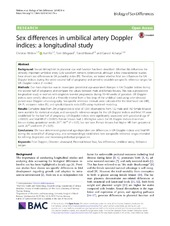| dc.contributor.author | Widnes, Christian | en_US |
| dc.contributor.author | Flo, Kari | en_US |
| dc.contributor.author | Wilsgaard, Tom | en_US |
| dc.contributor.author | Kiserud, Torvid | en_US |
| dc.contributor.author | Acharya, Ganesh | en_US |
| dc.date.accessioned | 2019-06-07T13:45:49Z | |
| dc.date.available | 2019-06-07T13:45:49Z | |
| dc.date.issued | 2018-04-18 | |
| dc.Published | Widnes C, Flo K, Wilsgaard T, Kiserud T, Acharya G. Sex differences in umbilical artery Doppler indices: A longitudinal study. Biology of Sex Differences. 2018;9:16:1-12 | eng |
| dc.identifier.issn | 2042-6410 | |
| dc.identifier.uri | https://hdl.handle.net/1956/19920 | |
| dc.description.abstract | Background Sexual dimorphism in placental size and function has been described. Whether this influences the clinically important umbilical artery (UA) waveform remains controversial, although a few cross-sectional studies have shown sex differences in UA pulsatility index (PI). Therefore, we tested whether fetal sex influences the UA Doppler indices during the entire second half of pregnancy and aimed to establish sex-specific reference ranges for UA Doppler indices if needed. Methods Our main objective was to investigate gestational age-associated changes in UA Doppler indices during the second half of pregnancy and compare the values between male and female fetuses. This was a prospective longitudinal study in women with singleton low-risk pregnancies during 19–40 weeks of gestation. UA Doppler indices were serially obtained at a 4-weekly interval from a free loop of the umbilical cord using color-directed pulsed-wave Doppler ultrasonography. Sex-specific reference intervals were calculated for the fetal heart rate (HR), UA PI, resistance index (RI), and systolic/diastolic ratio (S/D) using multilevel modeling. Results Complete data from 294 pregnancies (a total of 1261 observations from 152 male and 142 female fetuses) were available for statistical analysis, and sex-specific reference ranges for the UA Doppler indices and fetal HR were established for the last half of pregnancy. UA Doppler indices were significantly associated with gestational age (P < 0.0001) and fetal HR (P < 0.0001). Female fetuses had 2–8% higher values for UA Doppler indices than male fetuses during gestational weeks 20+0–36+6 (P < 0.05), but not later. Female fetuses had higher HR from gestational week 26+0 until term (P < 0.05). Conclusions We have determined gestational age-dependent sex differences in UA Doppler indices and fetal HR during the second half of pregnancy, and correspondingly established new sex-specific reference ranges intended for refining diagnostics and monitoring individual pregnancies. | en_US |
| dc.language.iso | eng | eng |
| dc.publisher | Springer Nature | eng |
| dc.rights | Attribution CC BY | eng |
| dc.rights.uri | http://creativecommons.org/licenses/by/4.0/ | eng |
| dc.subject | Fetal Doppler | eng |
| dc.subject | Obstetric ultrasound | eng |
| dc.subject | Placental blood flow | eng |
| dc.subject | Sex differences | eng |
| dc.subject | Umbilical artery | eng |
| dc.subject | Reference ranges | eng |
| dc.title | Sex differences in umbilical artery Doppler indices: A longitudinal study | en_US |
| dc.type | Peer reviewed | |
| dc.type | Journal article | |
| dc.date.updated | 2019-03-01T12:26:00Z | |
| dc.description.version | publishedVersion | en_US |
| dc.rights.holder | Copyright The Author(s) 2018 | |
| dc.identifier.doi | https://doi.org/10.1186/s13293-018-0174-x | |
| dc.identifier.cristin | 1587827 | |
| dc.source.journal | Biology of Sex Differences | |

